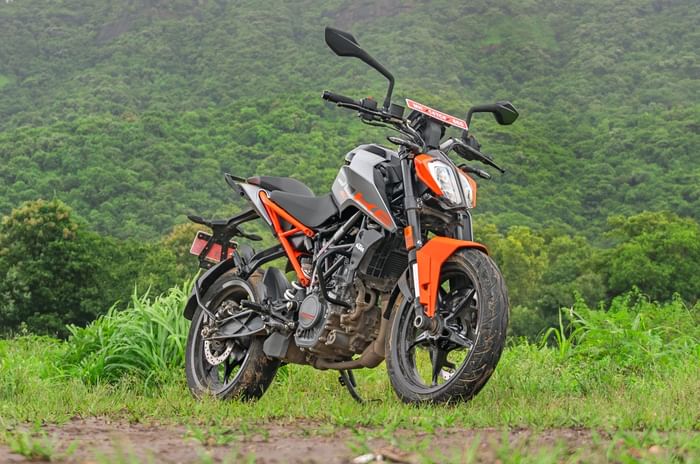The new entry level Duke is an exciting and competent machine.
Single minded motorcycles as the term suggests are machines created for a specific purpose. A sportbike is meant to slice up a track or a set of twisties, a cruiser is meant to amble along an open highway and so on and so forth.
Which is why I think the KTM 160 Duke is also a single minded machine. Not because of the sort of riding experience it was born to provide but it is a single minded machine because it was created to dethrone a certain blue motorcycle’s dominance in this part of the market.
KTM 160 Duke design and features – 8/10
Comes with supermoto ABS and a slipper clutch
Looking at these pictures you can see that there is a lot of visual similarity between the new 160 Duke and the bigger 200. That’s because both are based on the same gen 2 KTM Duke chassis architecture.
Its a sharp-looking thing and visually very similiar to the 200 Duke.
To this author’s eyes, the 160 Duke looks sharp, svelte and purposeful without going over the top like the latest 250 and 390 Dukes can sometimes feel. Quality is at a nice level all across and there’s very little stray wiring peeking out from underneath the bodywork – this is a neatly finished bike.
| Weight and dimensions | |
|---|---|
| Kerb weight | 147kg |
| Seat height | 815mm |
| Ground clearance | 174mm |
| Fuel tank capacity | 10 litres |
| Wheelbase | 1357mm |
Coming to the new 160 Duke’s feature-set, this is a decently feature rich machine for the class with a slipper clutch, supermoto ABS (rear off), full-LED lighting and Bluetooth connectivity for the LCD display if you purchase the optional bluetooth module priced at Rs 5,140.
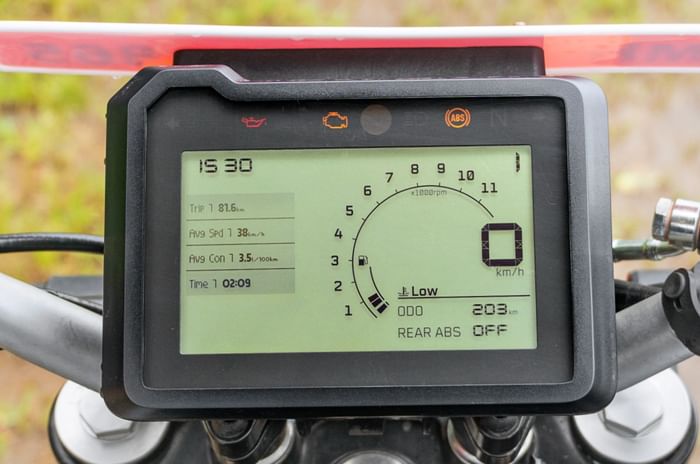
The LCD dash is well laid-out and the UI is intuitive and straightforward.
The 160 Duke uses the same left hand switch cube as all of its bigger siblings – this cluster is intuitive to use and is of a good quality as well.
KTM 160 Duke ride and handling – 9/10
Has a spacious riding position and well-judged suspension
The first thing you’ll notice once you’re perched atop the 160 Duke is its spacious and open riding position, unlike the latest 250 and 390. For taller riders like myself, this roomier riding triangle is more preferable in comparison to the tighter, more compact seating position on the bigger Dukes.
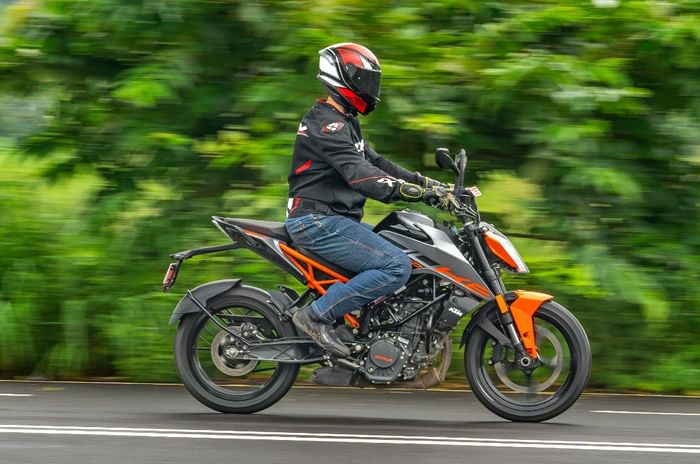
Despite its smaller displacement, the riding position is spacious for larger folks.
Bajaj has gone to great lengths to make the 160 Duke as light as possible and at 147kg, it is 12 kilos lighter than the 200. Some of the more noteworthy changes include slimmer frame tubes, a thinner 37mm USD fork, narrower pillion grab rails, new wheels seen on almost all India-made Duke and RC models and the 160’s engine is a kilo lighter than the 200’s block.
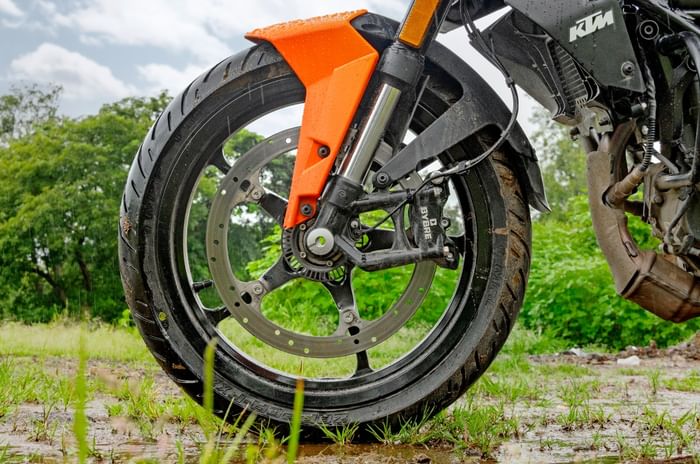
Latest-gen small-capacity KTM cycle parts used here; brakes work and feel great!
All that hard work has paid dividends once you get riding. The city is where the 160 Duke is certain to spend a large amount of its time and in that application it works very well. It’s light, flickable and manageable – all lovely attributes to tackle our unpredictable road infrastructure. And when you do decide to break free from the shackles of the urban jungle, the 160 Duke is good fun on a set of winding roads. It has genuine sporting ability in a very fun, KTM fashion and doesn’t feel like a dressed-up commuter in that sense.
| Suspension, tyres and brakes | |
|---|---|
| Suspension (F/R) | USD fork / Monoshock |
| Brakes (F/R) | 320mm disc / 230mm disc |
| Tyres (F/R) | 110/70-17 / 140/60-R17 |
The 160 Duke’s wheels and braking hardware are shared with the latest KTM models – not the 200 Duke, with which it shares a lot. This means you get a big 320mm rotor up front with a 4-piston radially-mounted caliper and organic brake pads. Despite the organic pads, braking power is commendable and these brakes are also very communicative as well as progressive – all attributes that will help the newer, less experienced sort of riders that are likely to gravitate towards the 160.
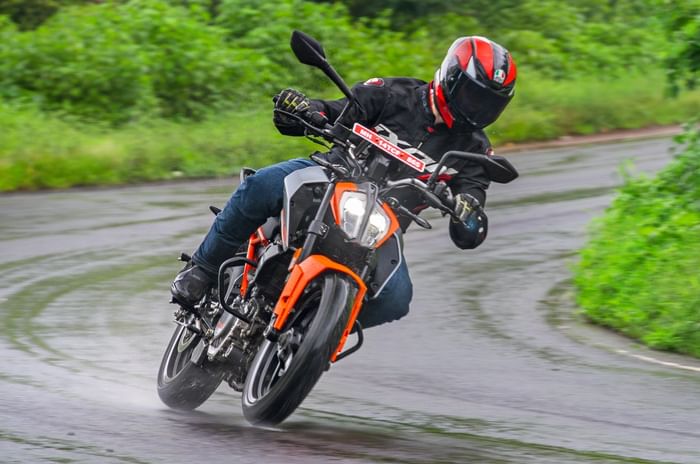
The chassis is well set-up and inspires confidence on the side of the tyre.
KTM 160 Duke engine and performance – 9/10
Rev-happy engine is fun to max out, its decently tractable too
Just like the taut chassis, the 160 Duke’s engine is also faithful to the KTM ethos. This is an engine that rewards chasing the redline (read mischievous behaviour) and wringing the throttle wide open to make forward progress is great fun! Happily, this addictive high-rpm thrill doesn’t come at the expense of hesitant city manners.
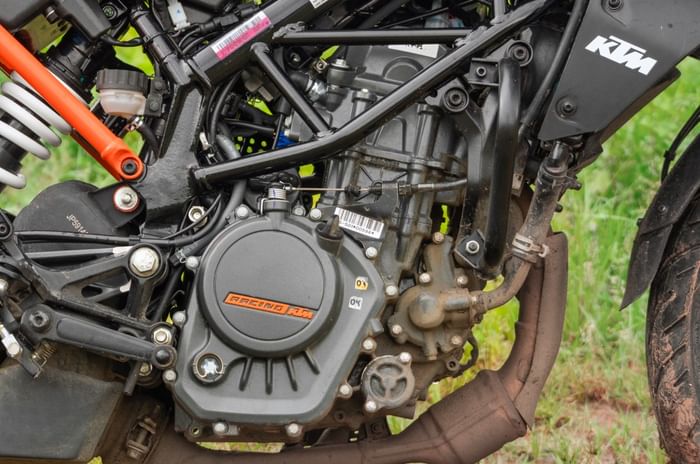
New 164cc motor is enjoyable and a great fit for a beginner bike like this.
The 160 Duke’s motor feels tractable and docile enough for city work but you get the sense that this little engine is its enjoyable best when you’re revving it hard. Part of the reason why its city manners are so good is its relatively modest 19hp/15.5Nm peak output and partly its super short gearing. Here, Bajaj has employed a 45 tooth rear sprocket which is 3 teeth more than the 200 Duke, which itself has always been aggressively short geared.
This super short gearing also means that you’ll hit the redline a little too quickly in every gear and also if you’re the sort that cares about top speed, you should see a figure around the mid-120s, which is a little lower than its arch rival from the tuning fork brand.
| Engine | |
|---|---|
| Engine | 164cc, single-cylinder, liquid-cooled |
| Power | 19hp at 9,500rpm |
| Torque | 15.5Nm at 7,500rpm |
| Gearbox | 6-speed |
KTM 160 Duke price and verdict – 9/10
The 160 is a small bike that’s big on fun
Speaking of that particular arch rival – which is the Yamaha MT-15, in case you’re wondering – let me first tell you why the 160 Duke replaced the 125 before we sum up. You see, in the Indian context, the 125 Duke always found itself fighting an uphill battle in comparison to similarly priced bikes. It had a genuinely sporty chassis but that 15hp engine really couldn’t justify its Rs 1.80 lakh sticker price because that price bracket includes some genuinely credible sporty 250s and even Bajaj’s own Pulsar NS400Z.

A full-blown comparison with the Yamaha is on the cards!
The biggest challenge, however, was posed by the Yamaha MT-15. The pared-back R15 promised peppy performance and aspirational brand value along with great fuel efficiency – a synergy no other bike at this price point was able to manage. This catalyst is exactly what triggered the inception of the KTM 160 Duke. Yamaha now sells over 10,000 MTs a month and that’s a market Bajaj simply couldn’t afford to overlook anymore. As of now, India is the only market the 160 Duke is sold with no immediate plans to export it elsewhere.
| Price | |
|---|---|
| Price (ex-showroom, Delhi) | Rs 1.85 lakh |
At Rs 1.85 lakh, the KTM 160 Duke is priced just a few thousand rupees more than the now discontinued 125 Duke. For that incremental jump you get a noticeable step up in performance, componentry and features, not to mention bragging rights – an important consideration for a buyer in this class. For someone that wants the image of having a KTM without the frantic performance or high initial purchase price, the 160 is a wonderful stepping stone into this mad orange world.
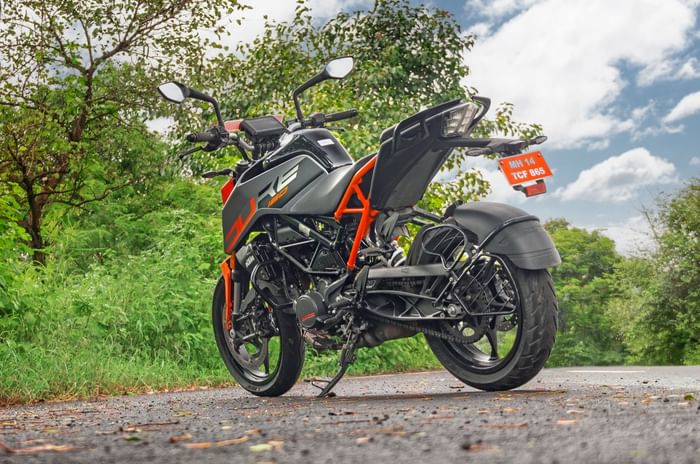
As a sporty first bike, the 160 Duke fits the bill very nicely.
And not just in isolation, even in comparison to the Yamaha, there are some areas where the KTM fares better. Only a full blown comparison will answer the question of which is the sporty, liquid-cooled, 160cc streetfighter to buy and that’s a story we hope to bring you very soon!
